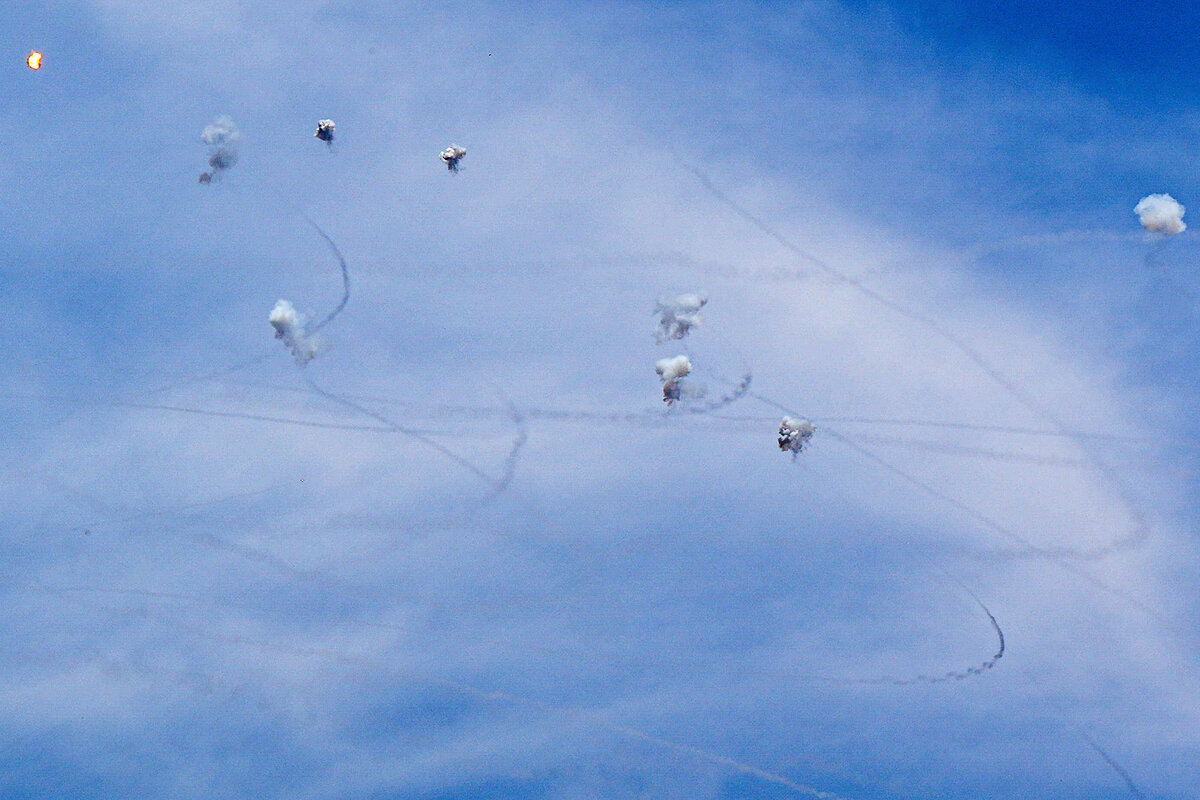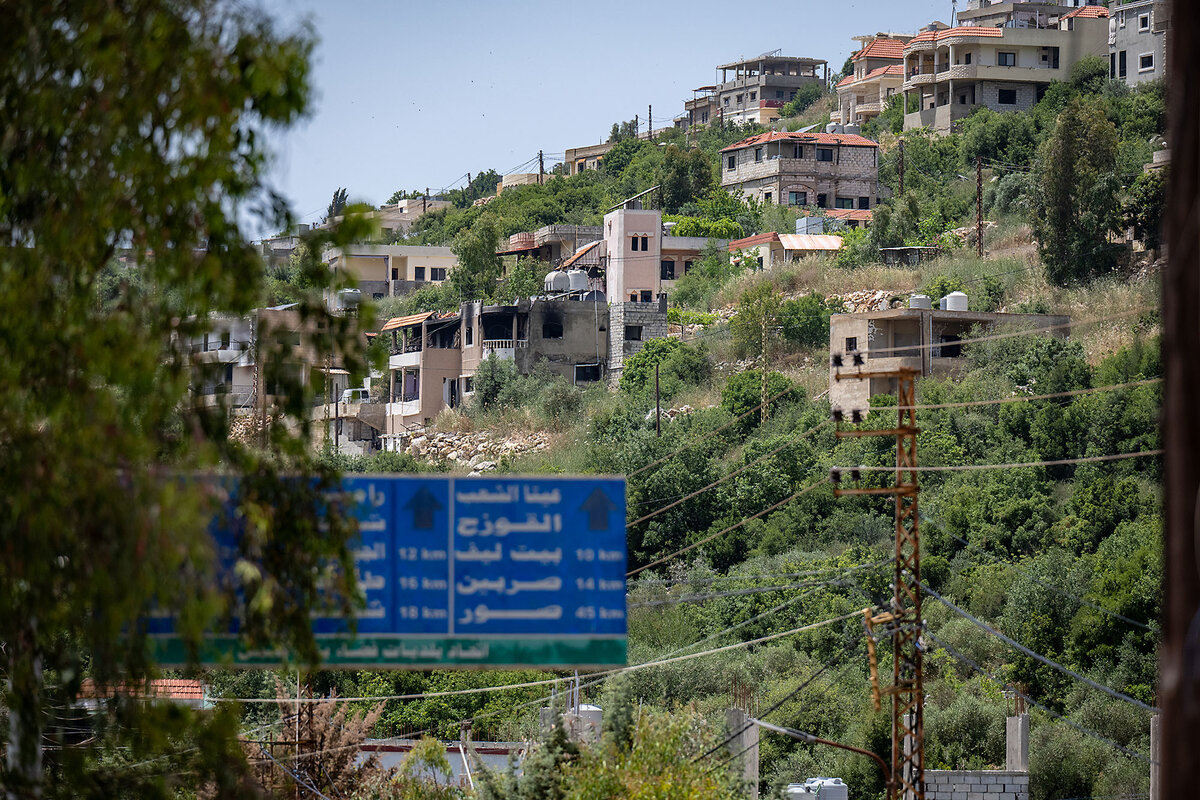To avoid war, Israel and Hezbollah shift their red lines. But war heats up.
Loading...
| NAQOURA, Lebanon
Overlooking an Israeli surveillance tower and a security fence that snakes inland from the Mediterranean, the watchtowers of the United Nations peacekeeping mission in Lebanon provide a front-row seat to one sliver of the escalating fight between Hezbollah and Israel.
On a recent afternoon, hot and with little sea breeze, the click-whoosh can clearly be heard of rockets fired toward Israel, from nearby stony ground thick with high scrub, by the Iran-backed Shiite Hezbollah militia. Within minutes, Israel responds with artillery rounds that whistle to their target and explode, just over the hill – the latest of some 13,000 projectiles the U.N. says have flown back and forth across this border in the previous month.
Shrapnel from previous rocket duels overhead has impaled solar panels here at the headquarters of the U.N. Interim Force in Lebanon (UNIFIL). Toward the west, amid a steady buzz of Israeli drones, swaths of low-forest cover have been burned by Israeli phosphorus munitions.
Why We Wrote This
A story focused onOn the Israel-Lebanon border, old adversaries Israel and Hezbollah know each other well, and what triggers the other. Since Hamas’ attack on Israel, the two sides have sought to avoid a full-scale war even as they appear to move closer to it.
Precision can be highly effective: Closed-circuit TV footage shows a motorcycle in recent days taking a direct hit, presumably fired by an Israeli drone against a Hezbollah operative, as it passed just feet away from the UNIFIL compound’s wall.
The escalation between Hezbollah and Israel along the Lebanon-Israel border has surged into a hot war since Hamas’ Oct. 7 attack on Israel. In support of Hamas, Hezbollah began to strike Israeli targets, in a series of escalating tit-for-tat exchanges.
What constitutes an action that would trigger an all-out war has evolved beyond recognition. Analysts say there is no obvious offramp, as long as the war in Gaza continues without a cease-fire – Hezbollah’s condition for calming this border.
A critical framework may be U.N. Security Council Resolution 1701, which in 2006 codified a cease-fire agreement that ended a monthlong war between Hezbollah and Israel but has never been fully implemented.
“The red lines still exist, and they still matter, and they are still important. But we have also seen a willingness on both sides to tolerate the violation of previously accepted red lines,” says David Wood, the Beirut-based senior Lebanon analyst for the International Crisis Group.
“That is not a safe basis to continue on. It’s better than both sides flying off the handle, but every single one of these operations risks breaching a red line – or one party changes its mind, and says we are no longer willing to accept these kinds of violations,” says Mr. Wood.
“It’s incredibly dangerous,” he adds. “The only safe way to manage this conflict is starting with a cease-fire in Gaza, but also a cease-fire at the border. Everything else is just damage limitation.”
While both sides have so far kept within newly expanding parameters, in clear efforts to avoid a broader war, the risks of miscalculation – and its devastating results – could not be higher.
Indeed, Hezbollah has barely scratched the surface of its arsenal, estimated at 150,000 rockets and missiles. Hezbollah leader Hassan Nasrallah warned last month that Israel had so far not seen “anything” of its capabilities.
And Israel has mounted a challenging invasion of Gaza that has absorbed the focus of its military, leaving little room or appetite right now for another full-blown war against Hezbollah.
“The fundamental difference is that Israel has repeatedly tried to assert that these are separate battlefronts, and will be dealt with separately,” says Mr. Wood.
“Hezbollah’s fundamental pledge is that, as long as there are atrocities being committed in Gaza, and as long as – in their view – Hamas needs Hezbollah, Hezbollah will not stand down at the border [or] enter into discussions about ‘the day after,’” says Mr. Wood.
So far, parallel diplomatic efforts by the United States and France since October to find a formula that calms this border have born little fruit. Some 90,000 civilians have moved away from the Lebanese side to safer areas, while some 60,000 Israeli civilians have been evacuated from northern Israel.
“The rhetoric is very high, but the reality is different,” says Andrea Tenenti, the spokesperson for UNIFIL, which has more than 10,000 blue-helmet troops from nearly 50 nations stationed in a border region south of the Litani River. All told, it accounts for 10% of Lebanese territory, and is packed with villages and towns, most of them with Shiite populations that support Hezbollah.
“Nobody really wants to start a wider conflict, but after seven months, the potential for a huge miscalculation – the potential for a larger escalation – is around the corner,” says Mr. Tenenti. “We can’t anymore think that this can continue forever.”
Resolution 1701 may be a critical framework for an eventual deal, and not just because it demands that both sides stop cross-border exchanges of fire. It also requires Hezbollah to pull back north of the Litani – a requirement that Hezbollah in recent years has brazenly flaunted, not only with weapons, but also by setting up firing ranges and observation posts near Israeli forces.
Israel is also meant to respect Lebanese sovereignty, but for years and almost daily has conducted military flights over and through Lebanese airspace, and moved into or held pieces of territory claimed by Lebanese.
Prior to October, progress had been made on seven out of 13 of Lebanon’s outstanding grievances. And UNIFIL facilitated more than 150 meetings since 2006 to de-escalate tensions, during which a senior Israeli officer sat at the same table as a Lebanese army officer on the border.
“There is no military solution; there is only a political and diplomatic solution to this conflict,” says Mr. Tenenti, noting that Hezbollah is significantly stronger than Hamas.
“There is not much that anyone can do until there is a clear solution in Gaza,” he adds. “This is the first time that we have a conflict here that has been triggered by something else. So it can’t only be controlled between Lebanon and Israel; it has to be solved somewhere else first.”
The transformation has been clear: “Before [October] if just one rocket was launched into Israeli territory, and retaliation, that could have definitely triggered a larger conflict. Now we are seeing thousands and thousands of trajectories, and you can see no one wants to start a [full-blown] conflict,” says Mr. Tenenti.
In the meantime, it is not clear how long both sides can continue to maintain the current escalatory equilibrium, such that more and heavier rockets and missiles reach deeper and deeper into each country.
“In some ways, it’s like asking someone playing Russian roulette how confident they are that they are not going to lose,” says Mr. Wood, the analyst. “Do I think it is on that level of risk? No. But equally, I can’t say ... the front on the south Lebanon border can continue for months, and there won’t be a disastrous expansion of the war.”









